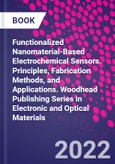Functionalized Nanomaterial-Based Electrochemical Sensors: Principles, Fabrication Methods, and Applications provides a comprehensive overview of materials, functionalized interfaces, fabrication strategies and application areas. Special attention is given to the remaining challenges and opportunities for commercial realization of functionalized nanomaterial-based electrochemical sensors. An assortment of nanomaterials has been investigated for their incorporation into electrochemical sensors. For example, carbon- based nanomaterials (carbon nanotube, graphene and carbon fiber), noble metals (Au, Ag and Pt), polymers (nafion, polypyrrole) and non-noble metal oxides (Fe2O3, NiO, and Co3O4). The most relevant materials are discussed in the book with an emphasis on their evaluation of their realization in commercial applications.
Application areas touched on include the environment, food and medicine industries. Health, safety and regulation considerations are touched on, along with economic and commercialization trends.
Please Note: This is an On Demand product, delivery may take up to 11 working days after payment has been received.
Table of Contents
Section A
Modern perspective in electrochemical-based sensors: Functionalized nanomaterials (FNMs)
1. Functionalized nanomaterial-based electrochemical sensors: A sensitive sensor platform
2. Recent progress in the graphene functionalized nanomaterial-based electrochemical sensors
Section B
Fabrication of functionalized nanomaterial-based electrochemical sensors platforms
3. Application of hybrid nanomaterials for development of electrochemical sensors
4. Biofunctionalization of functionalized nanomaterials for electrochemical sensors
Section C
Functionalized carbon nanomaterial-based electrochemical sensors
5. Functionalized carbon nanomaterials in electrochemical detection
6. Functionalized carbon material-based electrochemical sensors for day-to-day applications
Section D
Noble metals, non-noble metal oxides and non-carbon-based electrochemical sensors
7. Noble metals and nonnoble metal oxides based electrochemical sensors
Section E
Functionalized nanomaterial-based electrochemical based sensors for environmental applications
8. Functionalized nanomaterial-based environmental sensors: An overview
9. Advantages and limitations of functionalized nanomaterials based electrochemical sensors environmental monitoring
Section F
Functionalized nanomaterial-based electrochemical sensors technology for food and beverages applications
10. Attributes of functionalized nanomaterial-based electrochemical sensors for food and beverage analysis
11. The use of FNMs-based electrochemical sensors in the food and beverage industry
12. Trends in functionalized NMs-based electrochemical sensors in the food and beverage industry
Section G -�Functionalized nanomaterial-based electrochemical sensors for point-of-care applications
13. Functionalized nanomaterial-based medical sensors for point-of-care applications: An overview
14. Functionalized nanomaterial-based electrochemical sensors for point-of-care devices
15. Current trends of functionalized nanomaterial-based sensors in point-of-care diagnosis
Section H
Health, safety, and regulations issues of functionalized nanomaterials
16. Current status of environmental, health, and safety issues of functionalized nanomaterials
17. Functionalized metal and metal oxide nanomaterial-based electrochemical sensors
18. Functionalized nanomaterials and workplace health and safety
19. Layer-by-layer nanostructured films for electrochemical sensors fabrication
Section I -�Economics and commercialization of functionalized nanomaterial-based electrochemical sensors
20. Fabrication of functionalized nanomaterial-based electrochemical sensors' platforms
21. Advantages and limitations of functionalized graphene-based electrochemical sensors for environmental monitoring
22. TiO2 nanotube arrays grafted with metals with enhanced electroactivity for electrochemical sensors and devices
Section J -�Future of functionalized nanomaterial-based electrochemical sensors
23. Functionalized carbon nanomaterial-based electrochemical sensors: Quick look on the future of fitness
Authors
Jamballi G. Manjunatha Assistant Professor in Chemistry, FMKMC College Madikeri, Mangalore University, India.J G Manjunatha is an Assistant Professor in Chemistry at FMKMC College, A Constituent College of Mangalore University, India. He received his Ph.D. degree in Chemistry from Kuvempu University and Postdoc from the University of Kebangsaan Malaysia. His research interests focus on the fabrication of electrochemical sensors for the detection of biologically active molecules and the fabrication of binderless supercapacitors. He has received various awards and published more than 190 research articles in reputed International Journals. An editor for around 21 books books (RSC, ACS, IOP, Elsevier and Bentham science publishers), and special issues (IOP Science Publisher, Frontiers in Sensors, MDPI). He is also an editorial board member for many reputed journals and Editor -Chief Sensing technology journal (Taylor and Francis).
Chaudhery Mustansar Hussain Adjunct Professor & Director of Laboratories, New Jersey Institute of Technology (NJIT), Newark, NJ, USA.Chaudhery Mustansar Hussain is an Adjunct Professor and Director of Laboratories at the New Jersey Institute of Technology (NJIT), Newark, NJ, USA. His research focuses on the applications of nanotechnology and advanced materials, environmental management, analytical chemistry, and other various industries. He is a prolific author and editor for Elsevier, the American Chemical Society, the Royal Society of Chemistry, John Wiley & Sons, CRC Press, and Springer.








